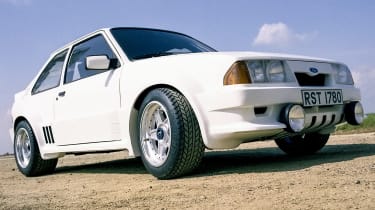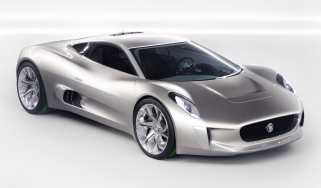Ford RS1700T – Dead on arrival
Even turbo power and a switch to rear-wheel drive couldn’t make the Mk3 Escort competitive against the upcoming mid-engined, 4WD weapons of 1980s rallying

After dominating 1970s rallying with the Mk1 and Mk2 Escorts, Ford entered the ’80s with a pair of interesting issues. The first was the Escort, which with the Mk3 of 1980 had switched to front-wheel drive. The second was their rally team, specifically that in 1979 they had sold it. This wasn’t as foolish as it might sound, however, because ditching everything related to the outgoing Mk2 Escort allowed the reborn rally department to start afresh; nor was the shift to front-drive the problem it might have been thanks to an upcoming and dramatic change in the regulations: Group B.
Under the codename ‘Columbia’, the Essex-based motorsport squad experimented with a heavily modified Fiesta before deciding, in 1981, to stick with the Escort. However, thanks to Group B rules that allowed wild deviation from showroom spec, its swollen hatchback shell would conceal a rear-drive chassis with lengthways engine and transaxle gearbox.
To power this new machine, Ford gave itself a choice of two possible power units: a 2.3-litre naturally aspirated four-cylinder made by race engine builder Hart, or a turbocharged version of the trusty Cosworth BDA, labelled BDT. To find out which was right they built two prototype cars, equipped one with the blown engine and one with the Hart unit, roped in Finnish hotshots Ari Vatanen and Pentti Airikkala, and went testing. The turbo car performed well while its nat-asp sister attracted derision from the drivers, and from there the decision was made: Ford’s new rally car for the ’80s would run the 1.8-litre turbo engine, though it would be badged Escort RS1700T to avoid confusion with the old RS1800.
> A trip on Ford’s private Boeing 737 – evo Archive
Unfortunately, while Ford was making up its mind about engines the Audi Quattro was embarking on a vivid demonstration of why the future would be four-wheel drive and, in light of this, the RS1700T project was forced to change tack. The rear-drive RS1700T would be readied as planned for the 1983 rally championship, complete with a batch of 200 homologation cars as required by Group B rules, but the team would also crack on with development of a four-wheel-drive version that would be homologated with another 200 representative examples ready for 1984.
This compromise wouldn’t be enough to save the 1700’s skin. In February 1983 old rallying hand Stuart Turner was appointed Ford’s director of European motor sports and rightly realised that the company had misread things more than it might admit. The future of Group B rallying wasn’t just four-wheel drive, it was mid-engined. A front-engined, rear-drive car hastily re-engineered with a new drivetrain wasn’t going to cut it and the RS1700T was cancelled, along with another expensive Ford motorsport programme, the C100 Group C racer.
The loss of both projects was not in vain, however, since Turner then commissioned an all new Group B rally car, this time mid-engined, using the promising BDT from the RS1700T and with a chassis by Tony Southgate, the freelance engineering guru now relieved of his workload on the C100. The result was the RS200.
As for the 18 RS1700T prototypes, many were shipped to South Africa, where relaxed regulations allowed them to rally as works entries, putting valuable test miles on the BDT engine before the RS200 was ready. A handful survive today including one which lives in Cumbria with the man who helped to develop it, former Ford works driver Malcolm Wilson.
The RS200, meanwhile, competed in just one championship season before Group B was cancelled at the end of 1986.






